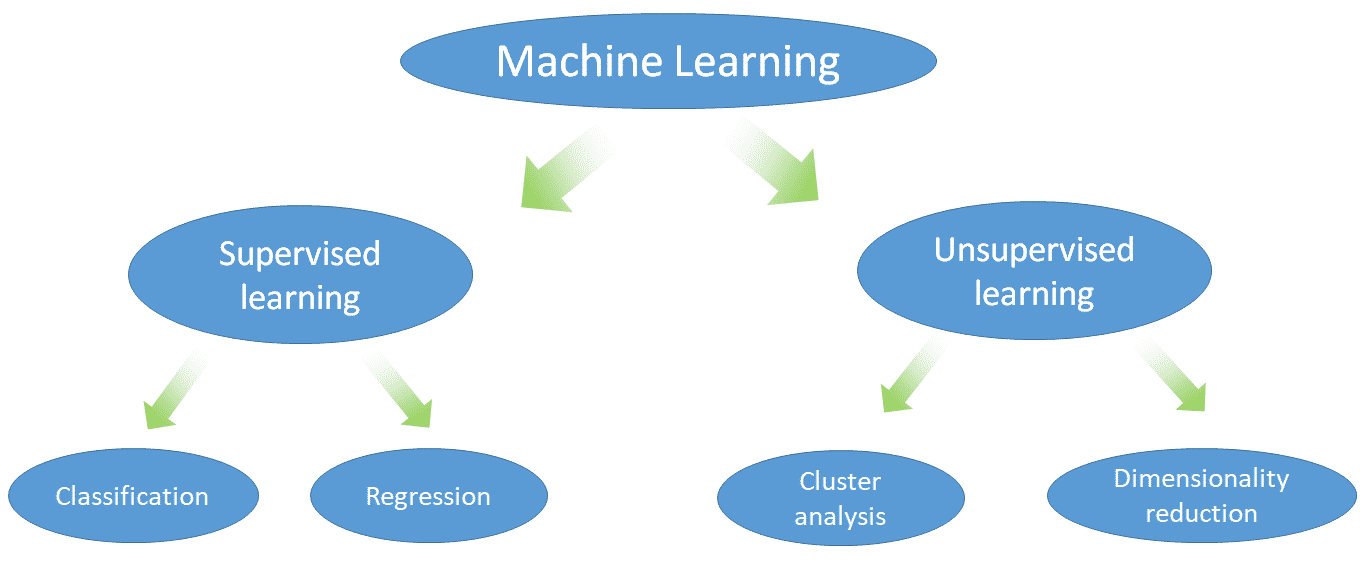Machine Learning definition
Machine learning is a discipline of artificial intelligence.
The main objective is to create systems that are able to learn automatically, ie they are able to find complex patterns in large sets of data on their own.
Types of algorithms used
The algorithms of machine learning are usually classified into two groups, on the one hand are the supervised algorithms that apply what has been learned with historical data to draw conclusions on new data and on the other hand are the unsupervised algorithms can extract inferences from data sets, although there are other types such as semi-supervised learning, reinforcement learning, multi-task and transduction learning.
Supervised learning
Supervised learning is a set of techniques that allows future predictions based on behaviors or characteristics analyzed in historical data.
The perdition obtained is represented by means of a function where the entries represent the analyzed characteristics and the output represents the variable that one wants to predict.
This output function is numerical in regression and categorical type problems in classification problems.
Regression
- Simple linear regression (R, Scala, Python, Spark-Python)
- R. Multiple linear (R)
- R. Logistics (Python)
- Neural Networks (R with Keras)
- ANOVA (R)
- Manova (R)
Classification
- Naive Bayesian quantifier (R)
- Logistic regression (R)
- discriminant Analysis (R)
- AdaBoost (R)
- Decision Trees (R, Spark-Python)
- Random Forest (R)
- Bagging (R)
- SVM (R)
Unsupervised learning
Unsupervised learning is a set of techniques that allow you to infer models to extract knowledge of data sets where a priori is unknown.
Cluster analysis
- Single and multiple Correspondence Analysis (R)
- Multidimensional Scaling (R)
- Hierarchical and partitioning cluster analysis (R, Spark-Python)
Reduction of dimensionality
Practical application of machine learning by sectors
Health
- Disease detection.
- Prediction of disease onset.
- Analysis of postural activity.
- Hospital stay prediction.
- Brain signal analysis.
- Classification of DNA sequences.
Retail
- Demand estimation.
- Pricing.
- Prediction of the behavior of the buyers.
- Customer segmentation.
- Customer search based on social network behaviors, web interactions…
- Optimization of WEB/mobile usability.
- Optimization of the hours that maximize the impact on social networks of a marketing campaign.
Logistics
- Predict failures in technology equipment.
- Application in data analytics from sensors.
- Predictive Maintenance in aeronautics
- Analysis of telemetry in cars.
- Prediction of aircraft delays.
- Predict urban traffic.
- Autonomous vehicles.
Financial
- Fraud detection in electronic transactions.
- Financial risk prediction.
- Recession prediction.
Energy
- Energy demand estimation
- Weather forecast.
Security
- Detect intrusions in a data communications network.
- Object detection.
- Anti-spam systems.
- Detecting malicious software.
Humans Resources
- Analysis of more profitable employees.





0 Comments